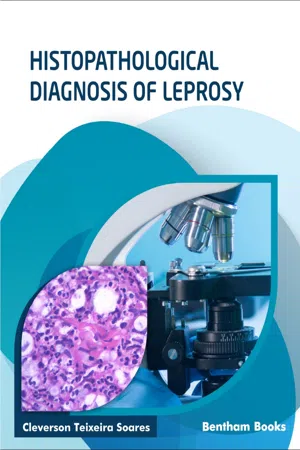
- English
- ePUB (mobile friendly)
- Available on iOS & Android
Histopathological Diagnosis of Leprosy
About this book
Histopathological Diagnosis of Leprosy, is a comprehensive guide to the medical pathology of Hansen's disease, which is a complex and clinically challenging infection caused by Mycobacterium leprae. Readers will find 8 chapters on key topics on the subject including general aspects of leprosy, different forms of leprosy (polar, borderline, etc.), reaction types and complications. The information presented in the handbook will equip the reader with the knowledge required to identify the disease in patients and perform differential diagnosis where required. Key Features: - 8 chapters dedicated to key topics about leprosy and its diagnosis - More than 200 figures featuring over 1000 clinical and histopathological photographs - Complete information about differential diagnosis and reaction phenomena - includes a section dedicated to special and complicated cases - References for further reading - Brings the expertise of renowned physicians to the reader The detailed presentation of the book is of great value to both healthcare professionals (pathologists, dermatologists, physicians) who are involved in the care of leprosy patients, and medical residents who are seeking information about the disease as part of their medical training.
Frequently asked questions
- Essential is ideal for learners and professionals who enjoy exploring a wide range of subjects. Access the Essential Library with 800,000+ trusted titles and best-sellers across business, personal growth, and the humanities. Includes unlimited reading time and Standard Read Aloud voice.
- Complete: Perfect for advanced learners and researchers needing full, unrestricted access. Unlock 1.4M+ books across hundreds of subjects, including academic and specialized titles. The Complete Plan also includes advanced features like Premium Read Aloud and Research Assistant.
Please note we cannot support devices running on iOS 13 and Android 7 or earlier. Learn more about using the app.
Information
Type 1 Reaction (T1R)
Cleverson Teixeira Soares
Abstract
INTRODUCTION

Clinical spectrum and bacilloscopic index of leprosy forms and reactions. Patients who are exposed to M. leprae can eliminate the bacilli through mechanisms of primary immune response and do not develop the disease. If the primary immune defense cannot contain the proliferation of the bacilli, the patient develops indeterminate leprosy (I), the early stage of the disease preceding the polarized forms of the Ridley & Jopling (R&J) classification: tuberculoid (TT), borderline-tuberculoid (BT), borderline-borderline (BB), borderline-lepromatous (BL) and lepromatous or virchowian (LL). Late recognition of bacillary antigens by the individual may result in an intense and effective immune response (TT and BT pattern), which may lead to the destruction of the bacilli and spontaneous cure. TT individuals are those with effective cellular immunity. If cellular immunity is not effective, proliferation and dissemination of the bacilli persist, and the disease progresses toward the lepromatous pole. LL individuals are anergic and react to the bacilli through humoral immunity. Type 1 reactions (T1R) affect patients in the range from TT to BL. Type 2 reactions (T2R) affect patients on the lepromatous side (BL and LL). The bacilloscopic index ranges from 0-6+.
Histopathological and Bacilloscopic Characteristics of T1R
Table of contents
- Welcome
- Table of Content
- Title
- BENTHAM SCIENCE PUBLISHERS LTD.
- FOREWORD
- PREFACE
- ACKNOWLEDGEMENTS
- DEDICATION
- Classification and General Aspects of Leprosy
- Indeterminate Leprosy
- Polar Forms (TT and LL)
- Intermediate or Borderline Forms (BT, BB, and BL)
- Type 1 Reaction (T1R)
- Type 2 Reaction (T2R)
- Regression and Relapse
- Lucio's Leprosy and Lucio's Phenomenon, Histoid Leprosy, Nodular Leprosy of Childhood, Primary Neural Leprosy, and Diagnosis Using Fine Needle Aspiration Cytology
- ABBREVIATIONS